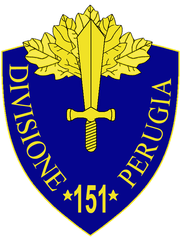151st Infantry Division Perugia
The 151st Infantry Division Perugia was an infantry division of the Italian Army during World War II. The Perugia Division was formed in August 1941 as a garrison division. It was sent on operations to Yugoslavia in December 1941. It was part of the Italian forces committed to the Battle of the Sutjeska. It was then transferred to Albania in August 1943. Following the Italian surrender in September 1943, the division marched from Girokaster to the Albanian coast, where some thousand men could be evacuated by ship to Italy, but the majority was left behind and was largely captured by the Germans of the 99 regiment, I Mountain Division, at "Porto Palermo". The commander of the "Perugia", gen. Ernesto Chiminello, was shot on October 4, 1943, at 16:45; the next day the other 120 officers were shot on the beach of "baia Limione" (a small bay just north of Sarande) and their bodies were thrown in the sea. The last 32 officers, after fierce resistance, were captured near Kuc and shot there on the morning of October 7, 1943.[1] Some survivors from the division joined the partisans, many others dispersed and tried to hide and survive in the woods; Bill Tilman reported in October 1943 that some 5,000 survivors from the "Perugia" and "Parma" Divisions were "living on roots and berries".[2]
| 151st Infantry Division Perugia | |
|---|---|
 151st Infantry Division Perugia Insignia | |
| Active | 1941–1943 |
| Country | Kingdom of Italy |
| Branch | Royal Italian Army |
| Type | Infantry |
| Size | Division |
| Nickname(s) | "Perugia" |
| Engagements | World War II
|
Order of battle
- 129. Perugia Infantry Regiment
- 130. Perugia Infantry Regiment
- 151. Artillery Regiment
- 29. CCNN Battalion
- 151. Mortar Battalion
- 151. Machine Gun Battalion
- 151. Anti-Tank Company
- 151. Engineer Battalion
- 59. Signal Company
- 15. Pioneer Company
- 151. Medical Section
- 151. Field Bakery
- 111. Carabinieri Section
- 112. Carabinieri Section [nb 1][1]
Notes
- Footnotes
- An Italian Infantry Division normally consisted of two Infantry Regiments (three Battalions each), an Artillery Regiment, a Mortar Battalion (two companies), an Anti Tank Company, a Blackshirt Legion of two Battalions was sometimes attached. Each Division had only about 7,000 men, The Infantry and Artillery Regiments contained 1,650 men, the Blackshirt Legion 1,200, each company 150 men.[3]
- Citations
- Marcus Wendal. "Italian Army". Axis History. Archived from the original on 2009-05-06. Retrieved 2009-05-04.
- Bailey, Roderick (2011-10-31). The Wildest Province: SOE in the Land of the Eagle. ISBN 9781446499542.
- Paoletti, p 170
- Paoletti, Ciro (2008). A Military History of Italy. Greenwood Publishing Group. ISBN 978-0-275-98505-9.
- Jowett, Phillip (2001-05-25). The Italian Army 1040-45 (3): Italy 1943-45. Osprey Publishing, Westminster. ISBN 978-1-85532-866-2.